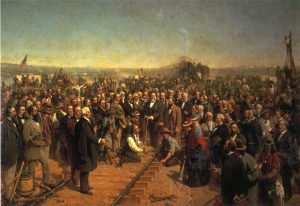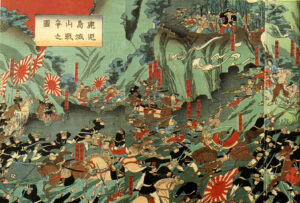Winner of the Fall 2016 StMU History Media Award for
Best Featured Image
Whenever we hear the name Notre Dame, one of two things might come to mind: the movie that we all watched and loved, about a man who rang the bells at a church, called “The Hunchback of Notre Dame,” or the notorious Fighting Irish football team in Indiana from Notre Dame University. Well, if you were hoping that this was an article on Quasimodo or the Division I football team, I am sorry to disappoint you. But do not be too discouraged because, instead, you will read about one of the most beautiful cathedrals that has ever been built (and it is in the film the “Hunchback of Notre Dame,” so that is relatively close). The Notre Dame de Paris, or as we call it in English, the Notre Dame Cathedral, is a massive Gothic cathedral that represents the times and art of medieval Europe.
The architectural style of Gothic came into existence in Europe in the mid-twelfth century and lasted until the sixteenth century.1 The idea of the Notre Dame de Paris, which translates to “Our Lady of Paris,” was established by Maurice de Sully in 1160 who was the bishop of Paris at the time.

He wanted to build a cathedral church dedicated to the Virgin Mary; hence the name’s translation. The first stone for the foundation was laid by Pope Alexander III in 1163.2 The Notre Dame Cathedral was built on the ruins of two previous churches in the eastern end of the Ile de la Cite, which is the “historical heart of the city.”3 The purpose for it being built, beside dedication to the Virgin Mary, was for it to be an education center. During the high middle ages, the increasing wealth and social complexity of the cities created the demand for educated individuals to deal with “political, legal, and theological issues.” The institution did not, however, hold classes inside of the cathedral. Instead, there was a school connected to the cathedral.4

Emerging from the Romanesque Era, the Gothic Age of architecture came along with its signature innovation: the flying buttress. You probably think I am joking with a name like that, but those types of appendages to the frames of Gothic cathedrals were what allowed for these cathedrals to be built so tall. During the Romanesque Era, cathedrals were much shorter due to the heavy stones that were used for building the walls, limiting how tall they could build. The classic Roman arches could not evenly distribute the weight with the dome shape they took.5
Now if we take a look at the cathedrals during the Gothic Age, the difference in height can be readily noticed. The cathedrals during this time seemed to tower over those of the previous era. For that, we can thank the flying buttresses that were mentioned earlier. These buttresses were able to absorb the weight displacement of the walls, allowing them to be made taller, and allowing them to have large spaces for stained glass windows, which were not possible for Romanesque cathedrals. The weight of the stones could be easily supported by the thin intersecting arches. The architects discovered that the outward thrust of the vaults were concentrated in the small areas at the springing of the ribs and were also deflected downward by the pointed arches; the pressure could be counteracted by the narrow buttresses. Rows of carved flying buttresses created the signature look for Gothic masterpieces such as the Notre Dame de Paris, Amiens, and Beauvais.6
The Notre Dame de Paris is a model cathedral for the era of Gothic Architecture. The multipurpose cathedral created an environment of religious and secular education that helped shape the minds of the world. I know that there was no mention of a “Hunchback” in this article of the Notre-Dame, but I can guarantee that Quasimodo was proud to ring the bells of such a monumental cathedral.
- Encyclopaedia Britannica, s.v. “Gothic Architecture.” ↵
- Columbia Electronic Encyclopedia, 6th Edition s.v. “Notre-Dame de Paris.” ↵
- Encyclopaedia Britannica, s.v. “Notre-Dame de Paris.“ ↵
- Earle E. Cairns, Christianity Through the Centuries: A History of the Christian Church (Zondervan, 1996), 234. ↵
- Funk & Wagnalls New World Encyclopedia, 2016, s.v. “Romanesque Art and Architecture.” ↵
- Funk & Wagnalls New World Encyclopedia, 2016, s.v. “Romanesque Art and Architecture.” ↵



125 comments
Alyssa Vela
I loved your introduction because you were able to capture my attention easily, as well as how you were able to keep my attention throughout the whole article. I love reading about the cathedral, and any information regarding it. Your description was amazing, and overall it was a great article! I look forward to reading more of your work in the future!
Natalia Zuniga
Loved the article, they way you started and approach it made it enjoyable and compelling. I knew what the name translated to, and I’ve been there! It great to find out how much it took to make such a magnificent creation happen. The cathedral is breathtaking in person and the way you described it and portrayed it made me remember it like I had been there yesterday!
Marissa Gonzalez
I loved the introduction to this article because it caught my attention. I could tell by the images which are displayed show that “Our Lady of Paris” is very beautiful and was constructed in a specific way. Flying buttresses helped the Cathedral stay sturdy and prevent it from caving in. Gothic architecture is very unique and beautiful in my opinion which is is why I loved this article. This is a place that I would like to go see for myself in the future. Great article!
Gabriela Serrato
I was so happy to come across this article and how it appreciates the Notre Dame Cathedral. I visited Paris this past summer and this cathedral was by far the greatest place I visited. Not only because I am a lover of the Disney movie, but because the architecture is so beautiful. It blows my mind how people in these times proved their dedication by producing such a magnificent sight. It is almost hard to believe when you are looking at the cathedral in person, and I am so grateful that it is in existence.
Aimee Trevino
Really well written article! From your explanations, it is clear that you did your research. I have always loved the architecture and beauty from the Notre Dame Cathedral displays, but I never knew the story of how religion came into play, and everything behind it. Really interesting to see all the story behind it, and how they were able to pull it off with limited technology, well done!
Lianna Ybarra
I really liked this article! You made an interesting topic into one that captures the reader with great word choice and little jokes here and there. I always thought the Notre Dame Cathedral was so beautiful and it is one of my goals to visit one day but I never knew it was named after the Virgin Mary. I remember learning about the gothic era during my world history class in high school and was very interested by the architecture and buildings that were built during this time.
Cameron Mays
This article was very well-written and some of the reasoning for that is because I believe it was very well-researched. Furthermore, the introductory paragraph was quite good and had be hooked from the very beginning. Your elegant prose only elongated this fact and would have taken my attention away from any mishaps in information at all. Nice!
Samuel Sanchez
Amazing article! I did not know much on the Cathedral. Knowing the whole back ground of the building and the purpose gives a whole new perspective into it. I liked how the article gives a connection to architecture of cathedrals during the Gothic Age. It was interesting how the main reason for the cathedral was for an education center even no classes actually held there.
Elizabeth Garibay
Very good article! Back in high school I didn’t enjoy history class at all but now I love learning about the history of such momentous buildings like the Cathedral of Notre Dame. Reading into it I know now it was a very important part of history. Overall it was very informative, great job. Looking forward to more interesting articles like these!
Alyssa Valdez
I never knew much about the Notre Dame Cathedral but after reading your article and seeing the pictures you presented, I had to look up more pictures and it is absolutely beautiful! What a very interesting topic to write about. I thought your article was very captivating, and very well written. As I said before I did not know much about Notre Dame so I thought this article was very informative!